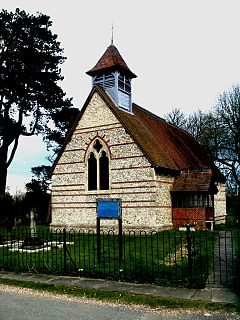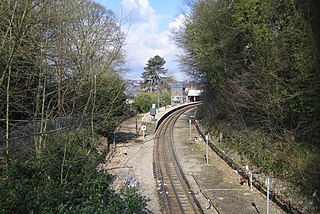Related Research Articles

Buckinghamshire, abbreviated Bucks, is a ceremonial county in South East England that borders Greater London to the south-east, Berkshire to the south, Oxfordshire to the west, Northamptonshire to the north, Bedfordshire to the north-east and Hertfordshire to the east.

Amersham is a market town and civil parish within the unitary authority of Buckinghamshire, England, in the Chiltern Hills, 27 miles (43 km) northwest of central London, 15 miles (24 km) from Aylesbury and 9 miles (14 km) from High Wycombe. Amersham is part of the London commuter belt.

Chesham is a market town and civil parish in Buckinghamshire, England. It is 11 miles (18 km) south-east of the county town of Aylesbury and 25.8 miles (41.5 km) north-west of Charing Cross, central London, and is part of the London commuter belt. It is in the Chess Valley and surrounded by farmland. The earliest records of Chesham as a settlement are from the second half of the 10th century, although there is archaeological evidence of people in this area from around 8000 BC. Henry III granted the town a royal charter for a weekly market in 1257.

Asheridge is a small hamlet in the parish of Chartridge, in Buckinghamshire, England. Prior to 1898 it was part of Chesham parish. It is situated in the Chiltern Hills, about two and a half miles north west of Chesham, 5 miles from Great Missenden and 6 miles from Wendover.

Bellingdon is a village in the civil parish of Chartridge, in Buckinghamshire, England. The name deriving from the Anglo Saxon Bellingdenu or Bella's Valley, and is recorded as Belenden in the 15th century. It is arranged along a ridge, typical of the Chiltern Hills to the north of Chesham.

Hawridge, is a small village in the Chilterns in the county of Buckinghamshire, England and bordering the county boundary with Hertfordshire. It is 3 miles (4.8 km) from Chesham, 4 miles (6.4 km) from both Tring and Berkhamsted. Hawridge is one of four villages comprising Cholesbury-cum-St Leonards, a civil parish within Chiltern District.

Slapton is a village and also a civil parish within Aylesbury Vale district in Buckinghamshire, England. It is located between the Grand Union Canal and the boundary with Bedfordshire, about 3 mi (5 km) south of Leighton Buzzard and 3 mi (5 km) west of Edlesborough.

Chiltern District was one of four local government districts of Buckinghamshire in south central England from 1974 to 2020. It was named after the Chiltern Hills on which the region sits.

Baron Chesham, of Chesham in the County of Buckingham, is a title in the Peerage of the United Kingdom created in 1858 for the Hon. Charles Cavendish, who had earlier represented Aylesbury, Newtown, East Sussex, Youghal and Buckinghamshire in the House of Commons as a Liberal.

Aylesbury is a constituency created in 1553 — created as a single-member seat in 1885 — represented in the House of Commons of the United Kingdom since 2019 by Rob Butler of the Conservative Party.

Ley Hill is a Chiltern village on the Buckinghamshire/Hertfordshire border in south-east England, near the town of Chesham. It is part of the civil parish of Latimer and Ley Hill, and comes under Chiltern District Council in the County of Buckinghamshire. Ley Hill lies in the Chiltern Hills and is contiguous with Botley.

Ehrenfried Pfeiffer was a German scientist, soil scientist, leading advocate of biodynamic agriculture, anthroposophist and student of Rudolf Steiner.

Charles Compton William Cavendish, 3rd Baron Chesham,, styled The Honourable Charles Cavendish between 1863 and 1882, was a British soldier, courtier and Conservative politician. He served as the last Master of the Buckhounds under Lord Salisbury from 1900 to 1901.

Whelpley Hill is a hamlet in the parish of Ashley Green in Buckinghamshire, England. It is located to the east of Chesham, near the border with Hertfordshire and is the site of an Iron Age hillfort.
Heather Nicholson is a British animal rights activist.

St. Mary's Church is a Grade I listed Anglican church in Chesham, Buckinghamshire, and is part of the Diocese of Oxford. Built on the site of a Bronze Age stone circle of puddingstones, parts of the church building date to the 12th century. Remodelled in the 15th and 17th centuries, the church is architecturally a mixture of English Gothic styles. Weakened by additions to the church tower and undermined by burials in and around the church, by the 19th century the building was structurally unsound. The church was remodelled and strengthened in the 1860s by George Gilbert Scott and again in the 20th century by Robert Potter.

The Chesham branch is a single-track railway branch line in Buckinghamshire, England, owned and operated by the London Underground. It runs from a junction at Chalfont & Latimer station on the Metropolitan line for 3.89 miles (6.26 km) northwest to Chesham. The line was built as part of Edward Watkin's scheme to turn his Metropolitan Railway (MR) into a direct rail route between London and Manchester, and it was envisaged initially that a station outside Chesham would be an intermediate stop on a through route running north to connect with the London and North Western Railway (LNWR). Deteriorating relations between the MR and LNWR led to the MR instead expanding to the northwest via Aylesbury, and the scheme to connect with the LNWR was abandoned. By this time much of the land needed for the section of line as far as Chesham had been bought. As Chesham was at the time the only significant town near the MR's new route, it was decided to build the route only as far as Chesham, and to complete the connection with the LNWR at a future date if it proved desirable. Local residents were unhappy at the proposed station site outside Chesham, and a public subscription raised the necessary additional funds to extend the railway into the centre of the town. The Chesham branch opened in 1889.
Ralph Whitlock (1914–1995) was a Wiltshire farmer, broadcaster, conservationist, journalist and author of over 100 books.
Will Bonsall is an American author, seed saver and veganic farmer who lives in Maine. He is a regular speaker about seed saving, organic farming and veganic farming.

Clarkson's Farm is a British television documentary series about Jeremy Clarkson and his farm in the Cotswolds. It was first broadcast by Amazon Prime Video on 11 June 2021, receiving overwhelmingly positive reviews. In July 2021, the series was renewed for a second season.
References
- ↑ Bullimore, John (20 July 1999). "Tony Harman". The Guardian . Retrieved 4 December 2011.